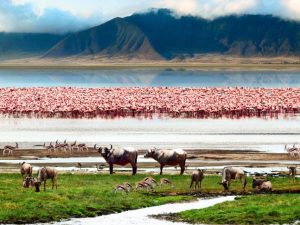Understanding Kilimanjaro Climb Elevation Gain
When embarking on a journey to conquer Mount Kilimanjaro, the tallest peak in Africa, understanding the elevation gain is crucial for a successful climb. The elevation gain refers to the total vertical distance ascended during the climb, and it plays a significant role in determining the difficulty and acclimatization process of the trek. In this article, we will delve into the importance of Kilimanjaro climb elevation gain and the factors that affect it.
Importance of Kilimanjaro Climb Elevation Gain
The elevation gain on Mount Kilimanjaro is a critical factor that climbers must consider when planning their trek. As you ascend the mountain, the air becomes thinner, making it harder for your body to get the oxygen it needs. Understanding the elevation gain will help you pace yourself, acclimate properly, and reduce the risk of altitude sickness.
The climb is typically broken down into several days, with each day involving a certain amount of elevation gain. By gradually increasing the elevation gain each day, climbers give their bodies time to acclimate to the higher altitude. This gradual ascent is crucial for preventing altitude-related illnesses and ensuring a successful summit attempt.
Additionally, understanding the elevation gain will also help you prepare physically and mentally for the challenges of the climb. By knowing what to expect in terms of steep inclines and high altitudes, you can train appropriately and build the necessary endurance for the trek.
Factors Affecting Elevation Gain on Kilimanjaro
Several factors can affect the elevation gain on Mount Kilimanjaro, making it important to be aware of these variables when planning your climb. The primary factors that influence the elevation gain include:
-
Route Selection: There are several routes to choose from when climbing Kilimanjaro, each with its own elevation gain and difficulty level. The Marangu route, for example, has a more gradual ascent compared to the Machame route, which involves steeper inclines and higher elevation gains.
-
Altitude Zones: Mount Kilimanjaro is divided into different altitude zones, each with its own elevation gain and acclimatization challenges. Climbers must ascend slowly through these zones to allow their bodies to adjust to the increasing altitude.
-
Weather Conditions: The weather on Kilimanjaro can be unpredictable, with changes in temperature, wind, and precipitation affecting the elevation gain. Climbers must be prepared for varying weather conditions and adjust their pace accordingly.
-
Physical Fitness: Your physical fitness level will also impact the elevation gain on Kilimanjaro. Climbers who are more physically fit will find it easier to tackle the steep inclines and high altitudes, reducing the risk of altitude sickness.
In conclusion, understanding the elevation gain on Mount Kilimanjaro is essential for a successful and safe climb. By considering the factors that affect the elevation gain and preparing accordingly, climbers can increase their chances of reaching the summit and experiencing the breathtaking views from the roof of Africa. For those interested in embarking on a Kilimanjaro climb, Sunset Africa Safari offers guided tours led by experienced guides. For booking inquiries, please contact info@sunsetafricasafari.com.


